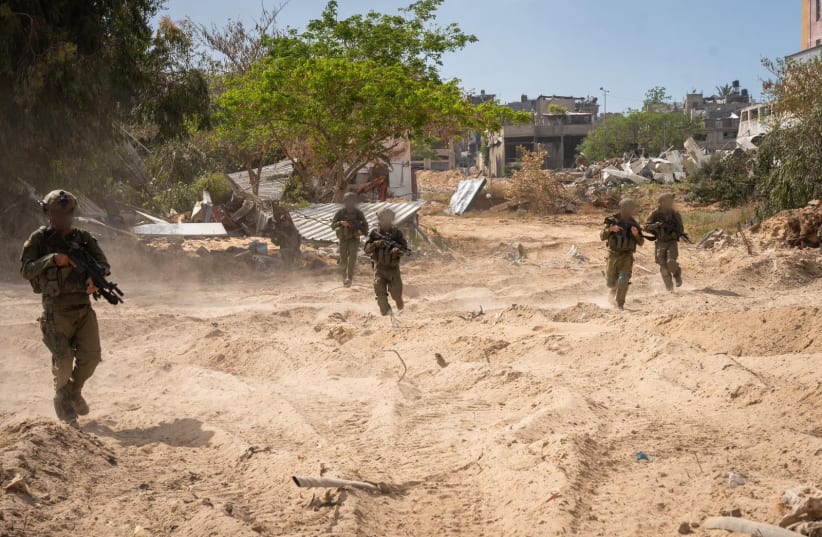The ceasefire proposed by the Biden administration splits the difference between Hamas and Israel on the critical issues facing the national security of both territories in the future.
It also leaves a variety of secondary – but still crucial issues – up in the air and open to being heavily influenced in one direction or another.
First, Israel has beaten Hamas as a national military organization in all parts of Gaza – that is an established fact.In October, Hamas hoped that it would retain all of its military power and control over Gaza and receive thousands of Palestinian security prisoners in exchange for the return of the Israeli hostages.
Hamas believed that Israel was weak, queasy around the blood of its soldiers, distracted by internal dissension, and afraid of global criticism. By taking operational control of most of the Rafah area (while so far avoiding some extremely densely populated areas), Israel has essentially taken apart all 24 Hamas battalions.
The 12 in northern Gaza fell quickly, four more in Khan Yunis and four in central Gaza, which fell by February, and another four in Rafah disintegrated over the last month.
Even if there is no ceasefire, top IDF officials have suggested that by around late June or early July – and possibly already – there will be no consistently organized national military Hamas group left to fight.
There are still many thousands, perhaps as many as 10,000 Hamas fighters who have fled into the civilian population, and are spread throughout the enclave in no particularly coherent or organized fashion.
But if IDF troops at any point this week entered Gaza City, Khan Yunis, central Gaza, or Rafah, there would no longer be any capable organized resistance.
As IDF sources have put it, if, at the start of the war, several thousand or tens of thousands of troops were needed to break into different parts of Gaza, taking weeks to do so, now a few hundred soldiers could penetrate anywhere in Gaza under an hour.
What is left of Hamas is smaller guerrilla and terrorist cells. These cells can quickly reunite and consolidate into somewhat larger groups if a vacuum is left, but they are no longer a safe and secure standing army.
In that sense, the IDF has done all the “warring” there was to do.So, ending the war now would not really be a gift to Hamas, not the way it would have been in October, before the invasion of the north, in December before invading Khan Yunis, or in April, before the invasion of Rafah.
But Hamas has not been defeated as the political ruler of Gaza.
Israel had, from around February until now, tried to propose or accept a proposal for replacing Hamas: whether it be Arab allies, the US/NATO, the Palestinian Authority, or some hybrid, and it never did.
BIDEN’S DEAL, which vaguely guarantees in “Phase Three” rebuilding Gaza without Hamas rearming or remaining in control, provides no way to ensure this.
Hamas has shown it is at its strongest when wrestling for internal control.
For a few days, Israel tried to get some local Gazan sheikhs to work with it against Hamas. The terror group had them assassinated.
There is no reason to think that anyone else who tries to replace Hamas, without the wrath of the IDF backing them up, will survive much longer.
Alternatively, in a slightly better scenario, Hamas might go with the Hezbollah formula: It could allow for a Gaza government and military formally independent of it, but ensure that they remain weaker militarily, such that it will control war and peace issues in Gaza the way Hezbollah is the behind-the-scenes puppet master of Beirut.
By allowing all Gazans to return to anywhere in the enclave, including the north, Israel will lose its largest bargaining chip over Hamas, and could make it harder for the IDF to make the easy penetrations that it can now make.
Will Israel keep its security zone strip around Gaza? Will Israel hold on to the Philadelphi Corridor?
Israel’s original war and peace plans included holding onto a security strip around Gaza, even if it did not enter Rafah.Would Israel now give up a major security component that the US was ready for it to keep had it ended the war back in November?
The IDF in Rafah took massive hits in terms of legitimacy in order to cut off Hamas from rearming via Egypt. The US threatened to cease offensive weapons transfers, the International Court of Justice ordered an end to Rafah operations, and the International Criminal Court issued arrest warrants for top Israeli leaders.
Will Israel now retain all the loss of legitimacy, while giving up this key strategic stranglehold on Hamas’s ability to rearm?
Another factor is the remaining number of hostages
Originally, Israel was going to get around 40 hostages in “Phase One” of the ceasefire before it withdrew from all of Gaza.
Under the latest deal, it may only get 15-20 hostages in “Phase One,” leaving Hamas much more leverage over the remaining hostages in later stages of negotiation, and potentially leaving the terror group immune to some future attacks.
At one point Israel was prepared to let Hamas survive by being expelled, in exchange for release of all of the hostages, but this option now seems like ancient history.
So Israel has reduced the Hamas military threat in the short and medium term, but Israel’s legitimacy has never been more badly damaged in the past 50 years. Also, it is giving up its leverage on issues which makes it more likely than not that Hamas will eventually make a comeback.
However, as problematic as the deal appears, given the government’s inability to decide who will replace Hamas despite having held the strongest cards for several months, it is unclear what other options Israel has beyond an endless war and more permanent harm to the Jewish state’s legitimacy.

